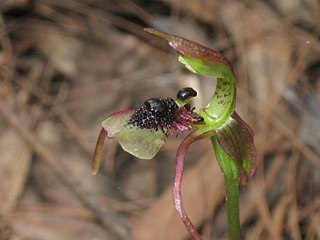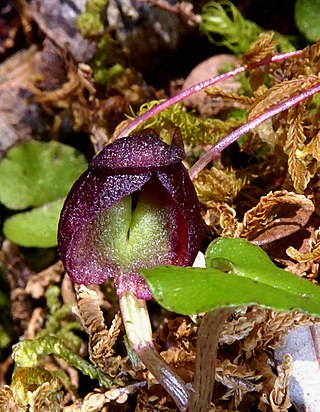
Vanilla, the vanilla orchids, forms a flowering plant genus of about 110 species in the orchid family (Orchidaceae). The most widely known member is the flat-leaved vanilla, native to Mexico and Belize, from which commercial vanilla flavoring is derived. It is the only orchid widely used for industrial purposes in flavoring such products as foods, beverages and cosmetics, and is recognized as the most popular aroma and flavor. The key constituent imparting its flavour is the phenolic aldehyde, vanillin.

Leptoceras menziesii, commonly known as rabbit orchid, is a plant in the orchid family, Orchidaceae and the only member of the genus Leptoceras. It is a slender plant, usually found in large colonies and which only flowers after fire. The flowers are small, white, pink and red on a stem up to 30 cm (10 in) tall and is endemic to southern Australia. It was one of the first orchids from Western Australia to be described and was given the name Caladenia menziesii, a name still used by some authorities.

Acriopsis emarginata, commonly known as the pale chandelier orchid, is a species of orchid endemic to Queensland. It is a clump-forming epiphyte with dark green leaves and curved, branching flower stems with many white and cream-coloured flowers.

Cattleya maxima is a species of orchid in subfamily Epidendroideae found from Ecuador to Peru.
Bulbophyllum cogniauxianum is a species of orchid in the genus Bulbophyllum found in Brazil.
Caladenia cleistantha is a plant in the orchid family Orchidaceae and is endemic to the south-east of Australia. It is a ground orchid which occurs as solitary plants and has a singly hairy leaf and one or two cleistogamous flowers..

Caladenia congesta, commonly known as black-tongue caladenia, is a plant in the orchid family Orchidaceae and is endemic to Australia. It is a ground orchid with a single, sparsely hairy leaf, and up to three bright pink flowers with the central part of the labellum completely covered with black calli. It is a widespread species but not common in any part of its range.
Prasophyllum tortilis is a species of orchid endemic to South Australia. It has a single tube-shaped leaf and up to ten purplish-brown and green flowers with a purple labellum. It is a recently described plant, previously included with P. fitzgeraldii, but distinguished from that species by its smaller number of smaller, more darkly coloured, short-lived flowers. It also resembles P. goldsackii but has fleshier flowers than that species.
Genoplesium alticola, commonly known as the tableland midge orchid, is a small terrestrial orchid endemic to Queensland. It has a single thin leaf fused to the flowering stem and up to twenty five small, hairy, dark purplish-red and green flowers. It grows in two small areas of the state at altitudes between 600 and 750 m.

Genoplesium vernale, commonly known as the spring midge orchid or East Lynne midge orchid is a small terrestrial orchid which is endemic to a small area on the south coast of New South Wales. It has a single thin leaf and up to twenty five dark purplish-black flowers with tiny glandular hairs on the sepals and petals.
Genoplesium validum, commonly known as the Blackdown midge orchid, is a species of small terrestrial orchid that is endemic to the Blackdown Tableland National Park in Queensland. It has a single thin leaf fused to the flowering stem and up to thirty five greenish-brown flowers with reddish stripes and a hairy labellum. This species is treated as Corunastylis valida in Queensland.
Pterostylis atrosanguinea, commonly known as the crowded banded greenhood, is a plant in the orchid family Orchidaceae and is endemic to the south-west of Western Australia. The plants either have a rosette of leaves in the years when not flowering or stem leaves on a flowering spike. When flowering, it has up to twenty flowers that are dark reddish to blackish brown with translucent white areas. The labellum is dark reddish black and covered with short, stiff hairs.
Chiloglottis longiclavata, commonly known as the northern wasp orchid, is a species of orchid endemic to Queensland. It has two leaves and a single narrow, pinkish green flower with a dark blackish red callus covering most of the upper surface of the labellum.

Chiloglottis seminuda, commonly known as the turtle orchid, is a species of orchid endemic to south-eastern New South Wales. It has two broad leaves and a single green or reddish pink flower with a shiny black insect-like callus covering two-thirds of the base of the labellum but with the tip of the labellum free of callus.

Chiloglottis trilabra, commonly known as the long-clubbed wasp orchid, is a species of orchid endemic to south-eastern Australia. It has two dark green leaves and a single greenish brown or pinkish flower with a dark red to black, ant-like callus covering most of the upper surface of the labellum. It is similar to both C. seminuda and C. reflexa.
Chiloglottis trullata, commonly known as the triangular ant orchid, is a species of orchid endemic to Queensland, Australia. It has two dark green leaves and a single small, green or pinkish flower with a shiny, dark reddish black, insect-like callus surrounded by reddish club-shaped calli covering most of the upper surface of the labellum.
Arthrochilus rosulatus, commonly known as rosetted elbow orchid, is a flowering plant in the orchid family (Orchidaceae) and is endemic to Tropical North Queensland. It has a rosette of bluish green leaves surrounding its base and up to fifteen pale green, insect-like flowers with dark red glands on its labellum.

Cryptostylis leptochila, commonly known as small tongue orchid, is a species of orchid that is endemic to eastern Australia. It has one to a few broad leaves and up to fifteen green flowers with a dark red labellum that has a black stripe and rows of black dots either side of the stripe. As with others in the genus, it is pollinated by male ichneumon wasps.

Pseudovanilla foliata, commonly known as the great climbing orchid, is a plant in the orchid family native to Queensland, New South Wales, and New Guinea. It is a terrestrial orchid with a vining vegetative habit, climbing by means of adventitious roots produced at nodes. Its leaves are reduced, and the species is considered to be at least partially mycoheterotrophic.

Corybas obscurus is a species of terrestrial orchid endemic to New Zealand. It has a solitary heart-shaped leaf and a deep crimson or nearly black flower and is part of the Corybas trilobus aggregate.











